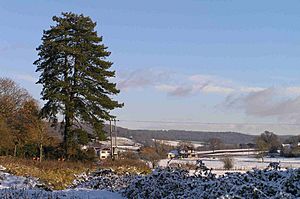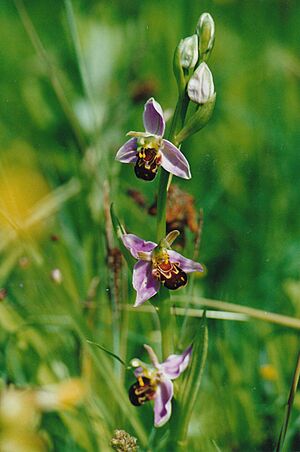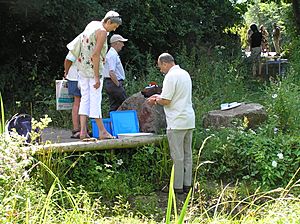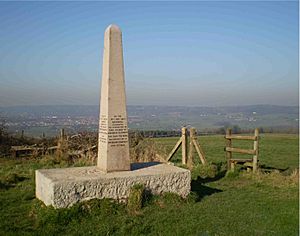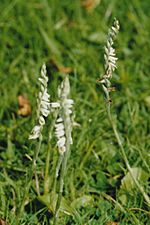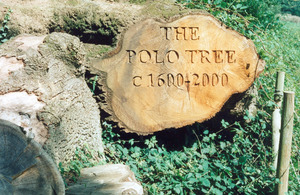Nature Reserves in Nailsea facts for kids
Nailsea, a town in North Somerset, England, is surrounded by amazing nature reserves. These special places protect local wildlife and plants. They are great spots to explore nature and learn about different habitats. Nailsea is located at 51°25′55″N 2°45′49″W / 51.43194°N 2.76361°W.
Contents
- Moorend Spout: A Wetland Wonderland
- Netcott’s Meadow: Home of Wild Orchids
- Stockway North Nature Reserve: A Community Project
- Backwell Lake: A Man-Made Wildlife Haven
- Jubilee Stone Wood and Badgers Wood Nature Reserves: Ancient History and Rare Species
- Nowhere Wood: A Place of Old Quarries and Bats
- Tyntesfield: A Grand Estate with Hidden Wildlife
- Towerhouse Wood: Bluebells, Bats, and Ancient History
- St George’s Flower Bank: A Blooming Roadside Reserve
- Images for kids
Moorend Spout: A Wetland Wonderland
Moorend Spout is a special nature area that covers six acres of land. It sits between the villages of Tickenham and Nailsea. This land was bought in 2009 with help from a special fund.
What Makes Moorend Spout Unique?
This reserve is mostly a wet meadow, located between two rivers called Land Yeo and Middle Yeo. Many small springs bubble up from the ground in an area filled with Alder trees. There's even a beautiful waterfall that flows under a bridge, which is part of a public walking path.
Wetland areas like Moorend Spout are becoming very rare in the UK. This particular spot is low-lying and often waterlogged, making it a perfect home for certain plants and animals.
Who Looks After Moorend Spout?
The Nailsea Environment & Wildlife Trust (NEWT) now owns and manages Moorend Spout. The people who run the trust hope to bring back the orchids that used to grow there.
Wildlife at Moorend Spout
You can find many different insects here, including colorful dragonflies and damselflies. If you're lucky, you might even spot Kingfishers or Otters enjoying the water.
Netcott’s Meadow: Home of Wild Orchids
Netcott’s Meadow is a small area of damp grassland. It is located north of Backwell Lake. This meadow is privately owned and is no longer open to the public.
Discovering Wildflowers
The meadow is famous for its many wild flowers, which are best seen in early June. Several types of orchids grow here. These include the Common spotted orchid, Southern Marsh Orchid, and Green-winged Orchid.
In some years, you can see many Bee Orchids. However, they might not appear every year. Another interesting plant found here is Yellow Rattle. This plant gets its name because its seeds rattle when shaken. It also gets some of its food by attaching to grasses and other plants.
Stockway North Nature Reserve: A Community Project
Stockway North Nature Reserve is located in the center of Nailsea. It covers about 0.75 acres. This area used to be Pennant Sandstone quarries in the 1800s.
From Quarry to Reserve
In the early 1900s, the quarries were filled with household rubbish. They were then left alone, and nature slowly took over. Local wildlife began to live there.
Work to clean up and restore the site started in 1996. A lot of the old rubbish was removed. In 1998, a group called The Friends of Stockway North Nature Reserve was formed. They manage the land with financial help from the local councils.
Goals of the Reserve
The group works to encourage wildlife and help people learn about nature. It also serves as a teaching resource for schools. The reserve is also an extension of the nearby Garden of Rest.
Backwell Lake: A Man-Made Wildlife Haven
Backwell Lake, also known as Bucklands Pool, was built in 1978 by Wessex Water. It was created as a balancing pond. This means it helps control surface water and prevents flooding in the River Kenn. It protects the area between the railway line and new homes south of Nailsea.
About the Lake
The lake is quite shallow, only about 2 meters deep at most. It covers an area of about 4 hectares. Today, it is a very important place for wildlife. It has been named a Local Nature Reserve.
Activities at Backwell Lake
Many water birds are attracted to the lake. It is open to the public for walking, dog exercise, and bird watching. Fishing is allowed, but with some rules.
Jubilee Stone Wood and Badgers Wood Nature Reserves: Ancient History and Rare Species
Jubilee Stone Wood and Badgers Wood Nature Reserves are mainly woodlands with open areas of limestone grassland. Both reserves are located high above the old village of Backwell, North Somerset.
Rare Animals and Plants
These reserves are home to many rare species. You might find the Hazel Dormouse or the Greater horseshoe bat. The Yellow Birds-nest plant also grows here.
A Glimpse into the Past
The reserves also have amazing historical sites. Some date back over 5000 years! There's a Neolithic human burial cave nearby. You can also find a 14th-century rabbit warren and cottage, 17th-century lead mines, and a 19th-century limekiln.
Nowhere Wood: A Place of Old Quarries and Bats
Nowhere Wood is a small wood also known as Trendlewood. The name Trendlewood seems to mean 'round wood'. The name Nowhere Wood comes from a small village linked to the wood by Nowhere Lane. This lane still runs through the wood today.
Nature's Takeover
The wood contains several old Pennant Sandstone quarries. These quarries were abandoned around 1900. Since then, trees and shrubs have grown to cover the old spoil heaps. Vegetation now hangs over the rock faces.
Wildlife and Restoration
Squirrels have built their nests in the trees. At dusk, you can see bats flying out to find food. A group called The Friends of Trendlewood Park has been formed. They are working to restore the wood, the surrounding parkland, and meadows. Their goal is to encourage more wildlife to live there.
Tyntesfield: A Grand Estate with Hidden Wildlife
Tyntesfield was once the home of the Gibbs family. In 2002, the National Trust bought it with help from many supporters. It is surrounded by 200 hectares of gardens, farmland, and untouched woodland.
Bats at Tyntesfield
The buildings at Tyntesfield have several bat roosts. Eight different species of bats are known to live in this area. A notable species is the Lesser Horseshoe Bat. Over 90 of these endangered bats have been counted roosting in the courtyard.
Other bat species found here include the Greater horseshoe bat, Brown Long-eared Bat, and Serotine Bat. You can also find Whiskered Bats and two types of Pipistrelle bats.
Glow Worms and Orchids
On a warm June night, you might see the female Glow-worm near the house at Tyntesfield. These beetles are becoming rare, possibly because city lights confuse the males. Glow Worms mainly eat snails and slugs, which are plentiful in this area. The beautiful Autumn Ladies Tresses orchid also grows on the lawn outside the main house.
Towerhouse Wood: Bluebells, Bats, and Ancient History
Towerhouse Wood is an ancient woodland located about 1 kilometer north of Nailsea. The Woodland Trust owns this site. It is famous for its Bluebells, very old Oak trees, and a pond that constantly produces gas bubbles.
Protecting Native Plants
Unfortunately, new types of trees and shrubs are growing in the wood. These non-native plants could take over and harm the native plants if they are not controlled.
Animals of the Wood
A wide variety of wild animals live in Towerhouse Wood. These include Dormice, Rabbits, Roe Deer, Badgers, Grey Squirrels, and five different species of bat.
Historical Discoveries
A lime kiln from 1769 can be found on private land in the northwest corner of the wood. To the south of the wood, there is a Mesolithic site. This site was first studied in 1956 and many worked flints were found there.
St George’s Flower Bank: A Blooming Roadside Reserve
St George’s Flower Bank is next to the main Portishead to Bristol road (A369). North Somerset Council owns it, and volunteers manage it.
Wildflowers Return
Seeds that had been sleeping in the soil began to grow when the ground was disturbed. These seeds produced wildflowers that are now rare in other places.
Managing the Meadow
The site is managed like a traditional hay meadow. The grass is cut and removed in late July. Scrub and trees that usually grow along roadsides are kept in check. This special management has helped the site become an official Local Nature Reserve.
Images for kids


